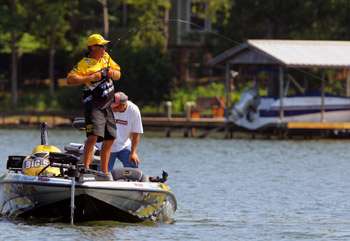
For a lot of bass anglers, summer means a search for the thermocline and the use of deep-diving crankbaits and Carolina rigs. But it doesn't have to be that way. There are still some shallow bass in any body of water. You just have to find them and figure out the right presentation. Elite Series pro Terry Scroggins has the answer.
Shallow water fishing is appealing for several reasons. You can see what you're casting to, it's obvious and it's usually very accessible. In all but the dirtiest water, you can see what the fish see with a good pair of sunglasses.
When fishing shallow in the summer, Scroggins believes, and he has proven, that you can be successful by keying in on different types of wood structure such as laydowns, shallow stumps and (his favorite) docks. Scroggins says that wood is the best cover in summer because the fish and baitfish can relate to it. It is solid and provides good consistent ambush points and, in the case of docks, shade all day long.
Knock on wood
Elite Series pro Terry Scroggins has made a reputation for himself as a superb shallow water fisherman. He says that shallow fishing has accounted for forty to fifty percent of his success — possibly more on unfamiliar waters. He believes that crankbaits are an essential part of any shallow water fisherman's arsenal.
"Shallow cranking is one of the best ways to get fish and stay in the game if you're not too familiar with the water you're on," he says. "It'll almost always work because it is so good at creating reaction bites, even when the fish are sluggish in the summer."
Scroggins prefers square-billed crankbaits for his wood work. The fact that they can crash into structure and not get hung up is favorable for aggressive cranking. The more you can hit the cover, the better, says Scroggins. He prefers Bomber's Square A baits in Foxy Shad for clear water and firetiger in darker water. A Castaway 6-foot medium action rod with Pflueger Patriarch 6.3:1 reel and 12- to 14-pound Gamma monofilament get the nod for his casting outfit.
To keep from spooking the bass, Scroggins parks his boat 15 to 20 feet away from the target wood, and casts past by about six feet. He casts beyond the cover to allow the bait to get to the optimum depth or bottom. Once he is satisfied he's in the strike zone, he will use a "stop and go" technique that keeps the bait moving up and down in the water column. After cranking vigorously a few turns of the reel, he will let the bait rise while taking up slack in the line, then repeat.
Skip it old school
But crankbaiting is not the only method he uses for shallow summer bassin'. He also likes to splitshot a plastic worm. One advantage of the technique is that it's exceptionally easy to use.
The most important part of split shotting is the cast," he says. "If you can skip it up under a dock, the bait will do the rest."
A number 8 split shot sinker clamped above the worm gives an action similar to a stickworm. The action is in the fall, he says. A Zoom Houdini Worm and an XCalibur wide gap hook, either 3/0 or 4/0, depending on the size of the bait, are his choices. He prefers spinning gear for split shotting, namely a Castaway 6-foot, 5-inch medium action rod with a Shimano Stella reel. Line size depends on water clarity, though he prefers monofilament for its stretch and abrasion resistance. Gamma 12-pound monofilament is used in stained water, while he switches to 8-pound Gamma fluorocarbon in clear water.
After casting under a dock or to a stump, Scroggins deadsticks the bait. This self-explanatory technique involves letting the bait fall immediately after it hits the water, and letting it sit motionless for as long as you can stand it. This allows the fish to get a good look at the worm. As Scroggins says, the key to this technique is in the cast — placement is critical.
If you're limited to shallow water fishing, or if shallow water is the only water on your lake, Scroggins says finding wood cover is the most important part of a successful day.




